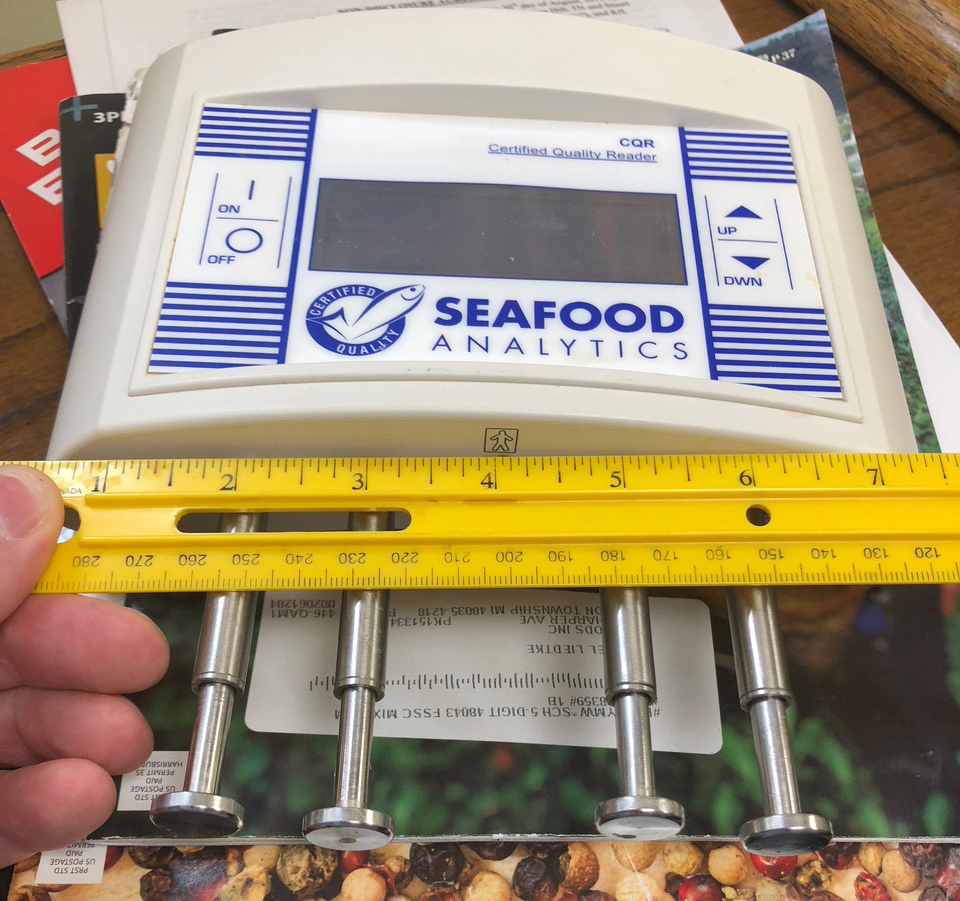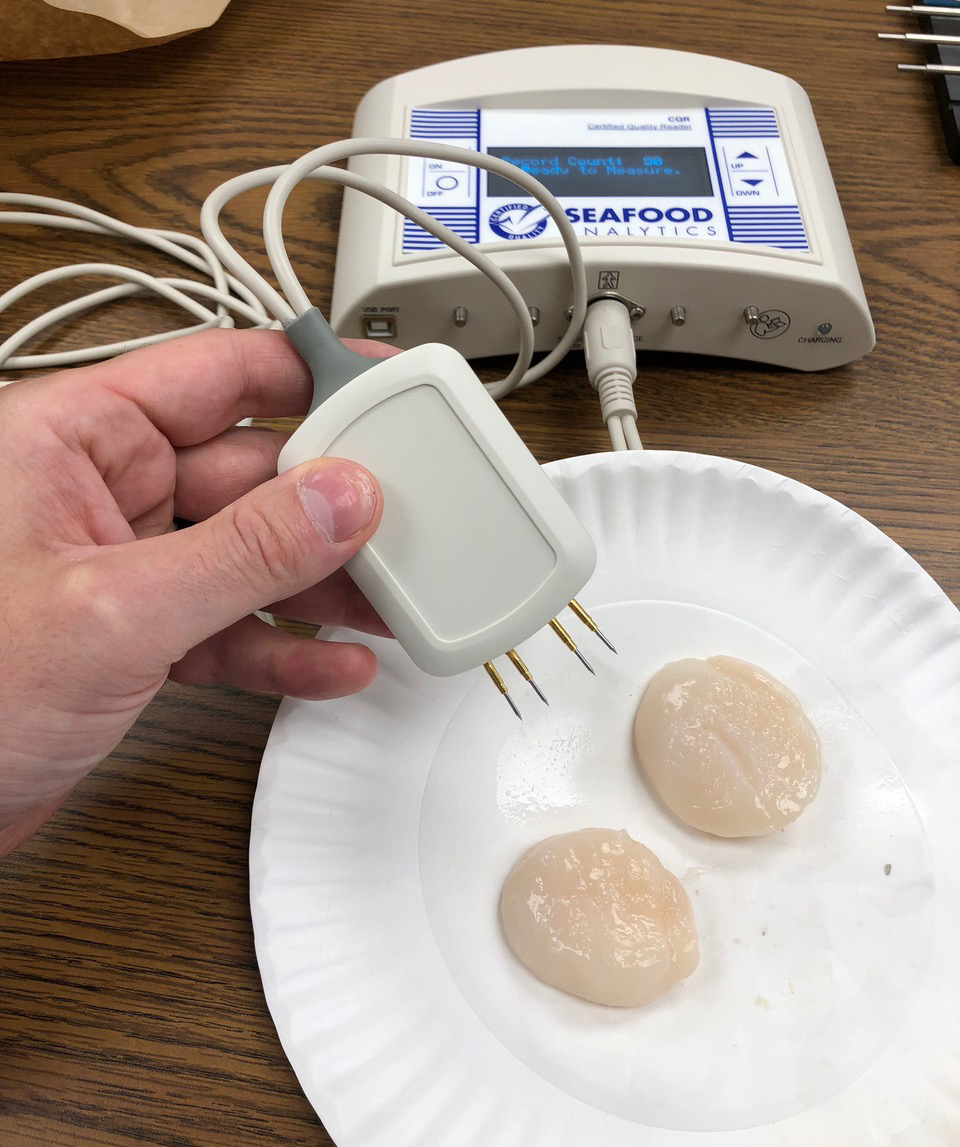Seafood Analytics’ device employs FDA-cleared for human use electrode technology

Those engaged in aquaculture face a problem – fish don’t talk. Neither do shrimp or any of the other aquatic species for that matter. Their silence makes determining their health status a difficult task.
“Right now, we don’t know that they’re sick until they die. But a lot of times they’re sick and they’re eating less and they’re growing less and we don’t really know it,” said Chuck Anderson, vice president of Seafood Analytics.
The company, based in Detroit, Mich., hopes to help producers become more proactive with a handheld device that’s suitable for assessing fish, shrimp or other aquaculture species. Called a Certified Quality Reader, or CQR, the device has electrodes that when pressed against the specimen send an electrical signal through the animal. The readout of that signal provides valuable information that, in effect, makes the fish answer health-related questions.
“You simply touch the side of the fish and in less than a second you get a measurement. Those measurements can be body composition or a health index,” said Keith Cox, Seafood Analytics co-founder.
Behind that simple description lie years of work, which began when Cox conducted research in college. The response to an electrical signal has been used for decades as a tool to determine body composition and health of humans. Indeed, the CQR is a U.S. Food and Drug Administration-certified class II medical device for human use that has been repurposed for use on aquatic animals, Anderson said.
When passed through a fish, shrimp or any other living organism, an electrical signal changes based upon the fat or other attributes of the animal. Those changes can be related back to standard wet chemistry lab tests, providing a correlation between what is detected electrically to such body composition components as percentage fat, water or protein.
There’s good agreement between the electrical and chemical tests, with the first having accuracy levels of 96.7 to 98 percent when compared to the second group, according to Seafood Analytics. The validation of the electrical approach was carried out in conjunction with Oregon State University, and results of the electrical signal method have appeared in scientific papers.
The traditional gold standard approaches to measuring body composition suffer from such drawbacks as being slow and requiring specialized chemicals, facilities and expertise. The method touted by Seafood Analytics, in contrast, is fast and doesn’t need anything more than the device itself and the animal being measured, according to Cox.

In addition to those benefits, the CQR offers other advantages, he pointed out. The data gathered is stored on the machine with the ability to separate it into lists. These lists can be based on any desired differentiator: species, tank, or anything else. Thus, fish can be monitored by tracking their vitality indicators or calculated results like overall health grade. The data gathering and number crunching happens without the need to write anything down or perform labor-intensive calculations.
Keeping the data in lists that distinguish between groups makes it possible to determine the impact of salinity, pH, ammonia level or one of the other 23 environmental factors that could play a role in an animal’s development. To that can be added such factors as different feeds and feeding schedules.
“It’s a way to do all kinds of trials for husbandry,” Anderson said.
To help carry such studies out, Seafood Analytics approach is an automated solution. The data from the device is uploaded and pushed into a database. Thus, the data collection device can be portable, with the more demanding analysis done on a more computationally powerful system. According to Anderson, the measurement device can store up to 8,000 readings and can run for days between charges.
Seafood Analytics is just entering the aquaculture market, with the measuring unit and software leased for $199 a month for a year term. This includes firmware and software upgrades at no extra charge. “We also provide expert consulting as part of the service,” Anderson said.
Right now, we don’t know that they’re sick until they die.
Anderson – who pitched the company and its technology at the most recent Fish 2.0 investor competition – added the company has been selling the same technology to the poultry processors for some time and several are currently using the technology. Anderson said that aquaculture companies are now looking into using Seafood Analytics’ products commercially, but the details are confidential. Researchers have used or are using the devices in their investigations, though.
For instance, students of Daniel Benetti, director of the aquaculture program at the University of Miami, have used the equipment to test tilapia and flounder. The version of the device used at the University of Miami does not have some of the latest improvements that help automation, such as the ability to store data in lists, according to Anderson. Still, the experience of Benetti and his students has shown that an electrical signal assessment of the health of fish or the quality of seafood during processing could be worthwhile.
“It is unquestionably very useful,” Benetti said of the electrical measurement approach, “and undeniably necessary as a tool to assist in quality control in the seafood industry with great benefits to all segments.”
Follow the Advocate on Twitter @GAA_Advocate
Now that you've finished reading the article ...
… we hope you’ll consider supporting our mission to document the evolution of the global aquaculture industry and share our vast network of contributors’ expansive knowledge every week.
By becoming a Global Seafood Alliance member, you’re ensuring that all of the pre-competitive work we do through member benefits, resources and events can continue. Individual membership costs just $50 a year. GSA individual and corporate members receive complimentary access to a series of GOAL virtual events beginning in April. Join now.
Not a GSA member? Join us.
Author
-

Hank Hogan
Hank Hogan is a freelance writer based in Reno, Nevada, who covers science and technology. His work has appeared in publications ranging from Boy’s Life to New Scientist.
Tagged With
Related Posts

Innovation & Investment
Global Aquaculture Innovation Award 2019 finalist: Pegasus Science
Global Aquaculture Innovation Award finalist Pegasus Science aims to simplify mycotoxin measuring in aquafeeds with near infrared (NIR) spectroscopy.

Aquafeeds
Waste not: Novel protein-recapture initiatives for aquaculture
A Norwegian fermentation technology firm utilizes volcanic matter to transform salmon waste, including feces and uneaten feed, into a high-protein powder.

Aquafeeds
With byproducts, getting more from – and for – fish
Use of fish trimmings and byproducts in fishmeal and fish oil is a win for aquaculture. But challenges loom, including logistics and economics.

Health & Welfare
Salmon scientists collaborate on new global health initiative QASH
A cooperative effort between salmon scientists in Norway, Scotland, Chile and Canada aims to develop a globally applicable tool to help management and certification of salmon farms.

